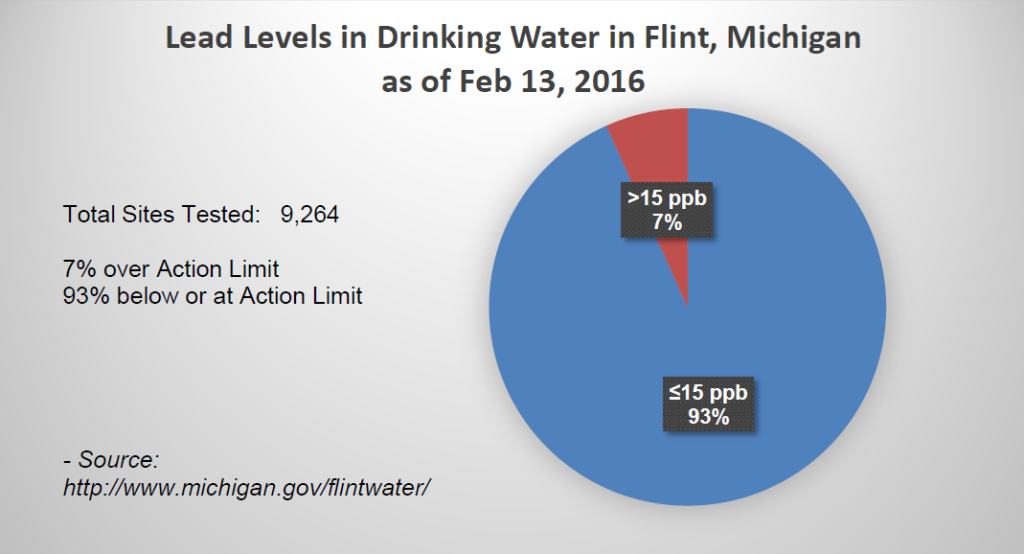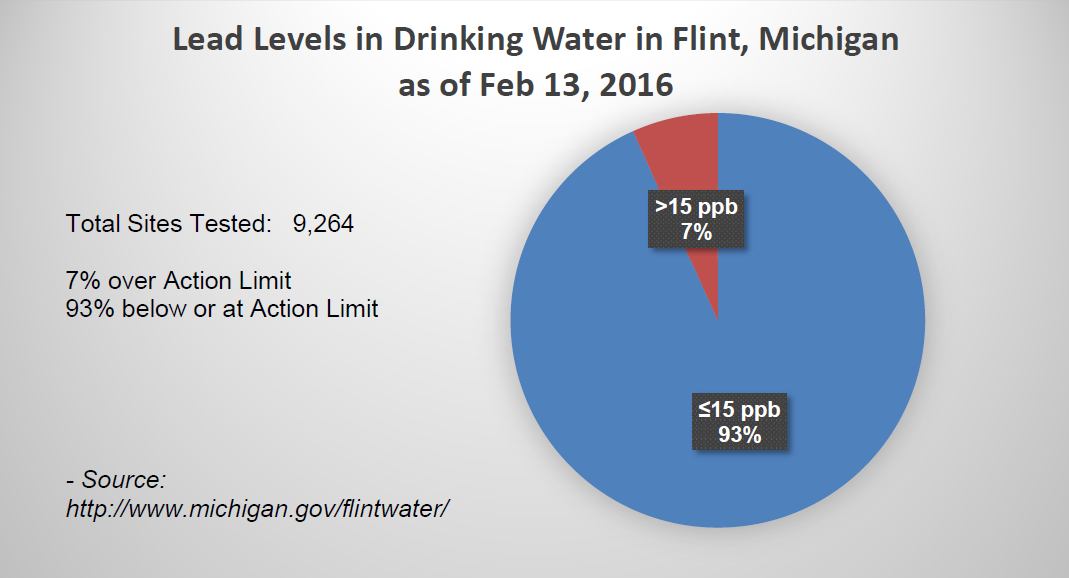One more week has gone by and there have been an additional 2,133 tests completed for lead and copper in Flint, Michigan. This brings the total number tested to date to almost one third of the 31,000 total users (number of total users from the city of Flint website). I've updated the pie chart showing little change in the percent of sites testing over the action limit for lead levels, now at 7% with a level of 9 ppb being the 90th percentile – well below the action level of 15.
 Fortunately I've noticed discussion of the situation in the media and online turning to a more well thought out direction with some realizing lead in the water is probably not the primary cause of the lead problem in Flint. People are also starting to realize Flint is no different than the majority of cities in the U.S., and all this testing is proving Flint is actually better off than many with respect to lead levels in their water.
Fortunately I've noticed discussion of the situation in the media and online turning to a more well thought out direction with some realizing lead in the water is probably not the primary cause of the lead problem in Flint. People are also starting to realize Flint is no different than the majority of cities in the U.S., and all this testing is proving Flint is actually better off than many with respect to lead levels in their water.
One article, "Two, Three… Many Flints – America’s Coast-to-Coast Toxic Crisis," does a good job discussing the lead risks posed by paint and how this is not just a problem for Flint, Michigan. The article also points out how focusing too much on Flint to the exclusion of all else and not acknowledging that cities all across America are in the same or worse state will ignore the larger problem. And this will mean that people in other areas will continue to face this issue as they do now with little to no help or education.
And while I like that the article, "Fixing Our Broken Water Systems" also acknowledges the problem is all over, it's concerning that the media is still pushing for full replacement of service lines and other requirements that will be costly, time-consuming, and more importantly not immediately solve the problem. Another suggestion in the article was for each city to conduct a census of homes to find all the lead lines. Anyone who has worked in the water industry understands this would not be a foolproof method because the line at the main and into the home can be copper, but any of the length in between could be lead. The only way to know for sure if a line has any lead pipe is to dig it all up, and it is not feasible to do so just to get a census done.
Using a GIS to help analyze the problem
Instead it would be beneficial for cities to check their old records to see if they have anything showing service line installations. One city where I worked still had old permits for each installation indicating the size and material for each service line. If a city has cards like Flint, they can hire someone to input all that data into a GIS or into an EXCEL table with addresses and then upload it into a Google Fusion table and map it like I did for the test results below. Once the data is in a GIS, someone could overlay the information to see if the lead tests results match up with the lead line records. If age of residence is known, that could also be used and overlaid with the other data.
A quick, easy fix for communities with lead issues
While a GIS can help a water system get a better handle on lead in their system, it still doesn't actually solve the problem. Adding phosphates will address the lead in the water issue, and it is a fairly easy method to implement. But I understand Flint has already done this, so the lead levels in the water problem appears to be covered. But what about the lead paint and the community's need and desire to specifically focus on solving the problem for their lower income population? Since this population primarily lives in rental housing, the city of Flint, which already has a Rental Inspection Program, could easily add lead-free requirements to their rental program by amending their ordinance.
Basically, in order to rent a unit in Flint, the city could require the landlord to provide proof the service line to the unit was either installed originally with a non-lead pipe or that if originally lead, it had been replaced. Additionally, the landlord would need to prove the home did not test positive for lead paint. Only with this lead-free certification could a unit be approved as a rental. This places the burden of cost on the landlord who is a business owner and has an obligation to provide a safe living environment for people who are paying him or her money to live there. This requirement would also assist people who have lower incomes and who have little to no control to improve the building or facilities on which they rely. According to the U.S. Census 2014 Housing Selected Characteristics for Flint, Michigan, 45% of their housing stock are rentals. Enacting this amendment to their Rental Inspection Program would go a long way towards ensuring people in their community are living in lead free homes.



